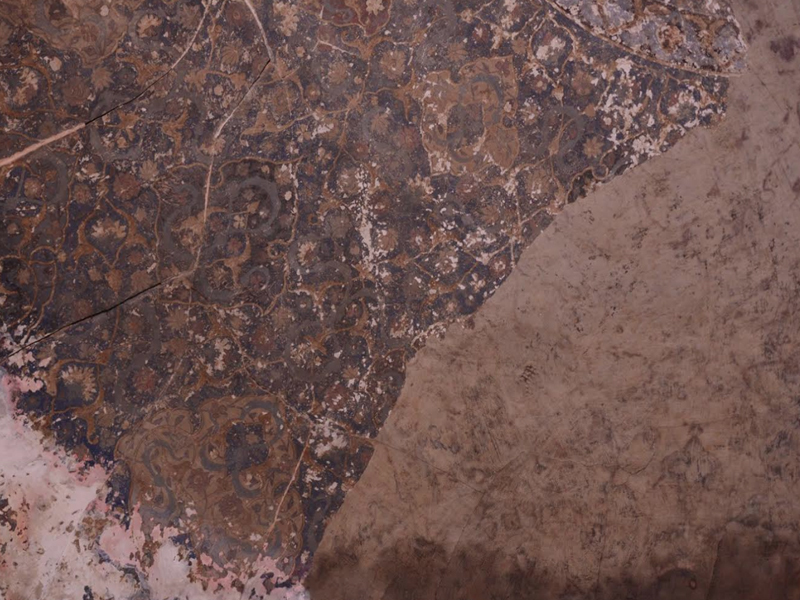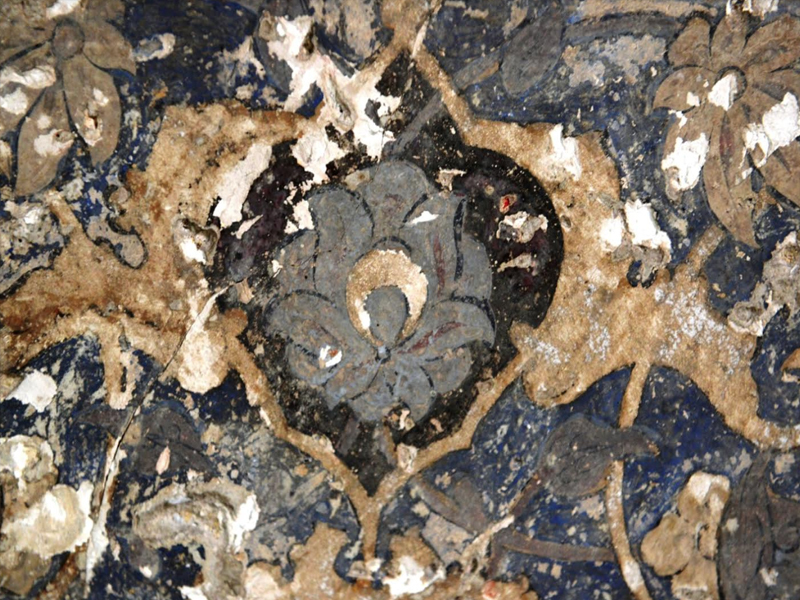Delhi: Sabz Burj
This is a collection of articles archived for the excellence of their content. |
A connection with the Mughals
Mughal wall paintings

From: Richi Verma, Conservators discover hidden Mughal treasure near Humayun's tomb, June 20, 2018: The Times of India

From: Richi Verma, Conservators discover hidden Mughal treasure near Humayun's tomb, June 20, 2018: The Times of India

From: Richi Verma, Conservators discover hidden Mughal treasure near Humayun's tomb, June 20, 2018: The Times of India

From: Richi Verma, Conservators discover hidden Mughal treasure near Humayun's tomb, June 20, 2018: The Times of India

From: Richi Verma, Conservators discover hidden Mughal treasure near Humayun's tomb, June 20, 2018: The Times of India
Conservators have made a stunning discovery on the domed ceiling of the 16th-century Sabz Burj, a Mughal monument near Humayun's tomb: hidden paintings in blue, yellow, red and white, and some even in gold. The conservators, working under the Aga Khan Trust for Culture and Archaeological Survey of India, and experts say this is the first time early 16th century wall paintings have been found on a monument in Delhi.
Sabz Burj (or Green Tower, although the dome is blue on the outside), is among the earliest Mughal buildings influenced by Timurid architecture and richly ornamented with incised plasterwork, glazed ceramic tiles and decorative lattice stonework. Conservation work began in November.
“On the removal of 20thcentury cement and lime-wash layers, remnants of 16th-century painted decorations were discovered on the domed ceiling which would have originally been completely covered with floral paintings with blue, yellow, red, white, and even gold, being the predominant colours,” said an official.
Though traces of wall paintings were visible on the wall surfaces, it was expected that the ceiling would be ornamented with the usual incised lime plaster patterns. But the painted ceiling stunned everyone.
“It seems much of the painting was lost due to seepage of rainwater and efforts are under way to ensure it never recurs. Portions of the plastered surface have also fallen away due to structural movement in the building,” said an official.
National and international experts have been roped in by the AKTC-Havells team to advise on methods to remove later layers and surface coating. “Further analysis of the painted pigments will be undertaken before formulating a conservation strategy for the painted ceiling,” an official said.
The project is supported by appliance major Havells as part of its CSR activity.
The 2021 restoration
Zumbish, Nov 18, 2021: The Times of India
As World Heritage Week begins, the conservation of Sabz Burj — a two-storeyed domed structure on the roundabout on Mathura and Lodhi roads in Nizamuddin — finally comes to an end. The Aga Khan Trust for Culture began work on the crumbling 1530s heritage building in 2018 in partnership with Archaeological Survey of India with the support of Havells.
Ratish Nanda, CEO of Aga Khan Trust, said, “Sabz Burj is a unique monument that boasts glazed tiles on the dome and a tall, elongated drum for the dome to rest on. Tiles matching the physical and chemical properties of the 16th century tiles have now been restored on the dome and the drum. All surviving original tiles were retained, even if they had lost their glaze.”
The most challenging work was to preserve the inner circle of the blue dome. The bottom of the dome’s outer circle gives it a unique appeal with the multi-coloured tiles that have now been restored. “Specialist art conservators led by Mumbai-based Anupam Sah painstakingly removed the cement plaster to reveal the painted ceiling — now considered the earliest painted ceiling in any Mughal structure,” said Nanda. The original painting was in pure gold and lapis lazuli, among other natural colours.
Craftsmen have restored the missing tiles on the drum of the Sabz Burj, while the missing sandstone lattice screens on the lower part of the structure have been revamped on all the four arched openings of the monument.
Sabz Burj sports a variety of intricate incised plaster decorative patterns of floral and geometric designs. The missing plaster patterns were remade on the basis of available evidence on each of the eight facades.
Apparently, in the 1980s, ASI removed the tiles from the dome and replaced them with terracotta ones instead of a quartz base used by the 16th century builders. “Owing to the variation in composition and their fixture on the dome with cement, the 1980’s work allowed water retention and caused loss of the painted ceiling. A large portion of the tilework on the drum was lost,” said a conservator. “The Lotus finial atop the dome has green tiles that lend the structure its name of Sabz.”
According to the conservators, since the building has no inscription, it is not clear whose mausoleum it is though extant research suggests it is the resting place of a royal who had lived in early Mughal period. The turquoise tiles of the hue found on Sabz Burj have also been used at the nearby Humayun’s Tomb.